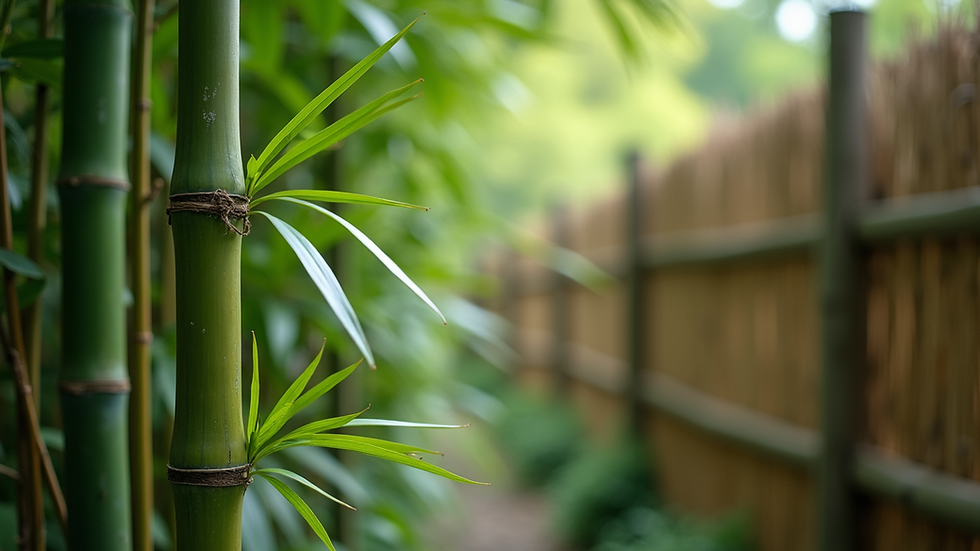The Rise of Eco-Friendly Fencing Solutions for Sustainable Modern Homes
- David Michell
- Jul 28
- 4 min read
As sustainability becomes a priority for many, eco-friendly options are crucial in every aspect of our lives, including fencing. Fencing is more than just a boundary marker; it enhances security and aesthetics around homes. Fortunately, eco-friendly fencing solutions are now available, allowing homeowners to meet their sustainability goals without sacrificing style or quality. In this post, we will delve into the various sustainable fencing options available, their advantages, and what sets them apart in today’s market.
Understanding Eco-Friendly Fencing
Eco-friendly fencing is crafted to reduce the environmental impact with renewable and recycled materials. Unlike traditional fences that often use non-renewable resources or treated woods laden with chemicals, sustainable options typically involve responsibly sourced materials or innovative designs that minimise waste.
The market is filled with eco-conscious designs that fulfill the practical and aesthetic needs of homeowners. Options range from elegant wooden posts to sturdy concrete gravel boards, enabling homeowners to select materials that reflect their commitment to sustainability while enhancing the beauty of their properties.
Benefits of Eco-Friendly Fencing
Choosing eco-friendly fencing offers several benefits beyond just reducing environmental impact. Here are some compelling reasons to consider sustainable fencing solutions:
1. Reduced Environmental Impact
Eco-friendly fences use sustainably sourced wood or recycled materials, significantly lowering the carbon footprint linked to traditional fencing. For example, using reclaimed wood can eliminate the need for new trees to be cut down. Bamboo, a fast-growing plant, can be harvested every three to five years without deforestation, making it an excellent sustainable choice.
2. Durability and Longevity
Many eco-friendly options like composite materials and concrete prove more durable than traditional wood. According to research, composite fencing can last up to 30 years without warping, rotting, or fading. This longevity means fewer replacements over time, further reducing resource consumption.
3. Enhanced Property Aesthetics
Today's eco-friendly fencing solutions come in various styles to suit every taste. Whether you prefer sleek, modern panels made from recycled materials or rustic wooden boards, there is something for everyone. For instance, a property could feature a striking fence made from ethically sourced cedar, paired with lush landscaping for a stunning finish.
4. Local Sourcing Opportunities
By choosing sustainable materials, homeowners often support local suppliers. Sourcing fencing materials locally can cut transportation-related emissions significantly. For instance, by purchasing from a local lumberyard rather than a national chain, you reduce the carbon footprint associated with long-distance shipping.
5. Increased Property Value
Eco-friendly upgrades can boost property value. According to a study by the National Association of Realtors, homes with sustainable features can sell for an average of 10% more than comparable properties without green upgrades. Investing in eco-friendly fencing can make your home more appealing to prospective buyers.
Popular Eco-Friendly Fencing Materials
When exploring eco-friendly options, consider these standout materials:
1. Bamboo Fencing
Bamboo is a fast-growing renewable resource that can be sustainably harvested. It is lightweight yet exceptionally durable and comes in various styles. Bamboo fencing not only looks good, but it can also last for decades with proper care.
2. Recycled Composite Fencing
This material combines recycled plastic and wood fibers, offering the visual appeal of wood with enhanced durability. Composite fencing resists rotting, insects, and fading, parents of young children or pet owners especially appreciate the low-maintenance aspect.
3. Naturally Durable Woods
Cedar and redwood are examples of naturally durable woods. When ethically harvested, they are strong and resistant to decay. A wooden fence using these materials can last over 25 years with minimal upkeep.
4. Concrete Fencing
Concrete panels are becoming popular due to their exceptional durability and low environmental impact. A well-installed concrete fence can last upwards of 50 years, often without any maintenance, making it a wise long-term investment.
5. Steel Fencing
Steel made from recycled materials can also be a sustainable pick. Steel is incredibly resilient and can be recycled at the end of its life, making it a durable and eco-friendly choice. A steel fence may last over 40 years, and it often requires little maintenance.
Installation and Maintenance Considerations
Choosing eco-friendly fencing requires careful attention to installation and maintenance. While these materials tend to be durable, proper installation ensures they perform effectively and endure longer.
Homeowners should work with professional fencing suppliers to assess site conditions and make informed choices about styles and materials. It is wise to discuss maintenance needs, such as whether wooden posts require staining or sealing, to preserve their beauty and integrity over time.
With the correct products and maintenance strategies, homeowners can enjoy the benefits of eco-friendly fencing while supporting a lifestyle rooted in sustainability.
Embracing Sustainable Solutions
The rise of eco-friendly fencing reflects a growing commitment to sustainable living. Modern homeowners can enjoy practical benefits, aesthetic improvements, and a positive environmental impact. By choosing responsibly sourced, durable, and attractive materials, you can elevate your property while supporting a greener future.
Next time you're considering a fencing upgrade, think about moving beyond conventional options. Opt for sustainable alternatives that enhance your home and contribute to protecting our planet for future generations.



Comments